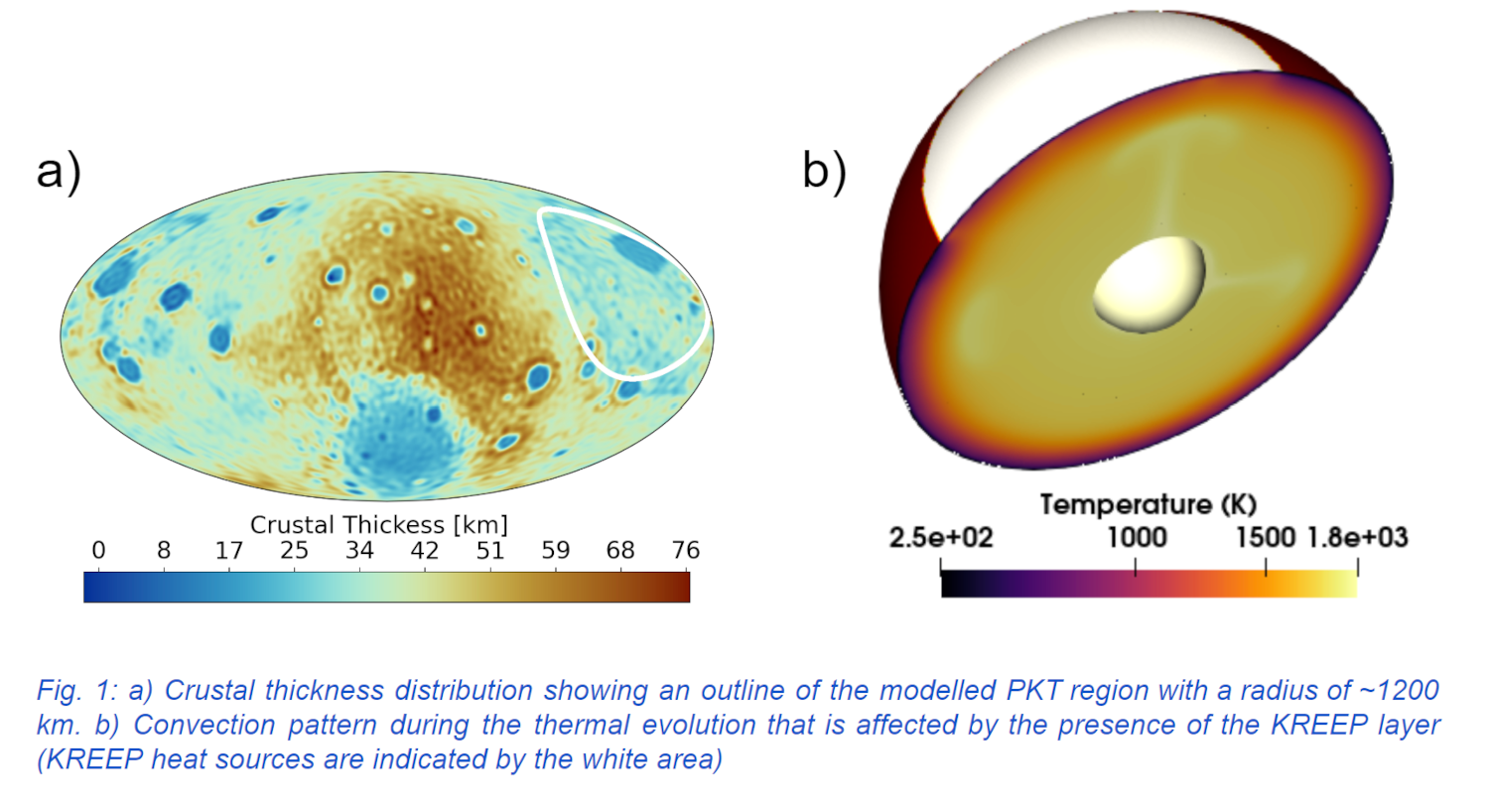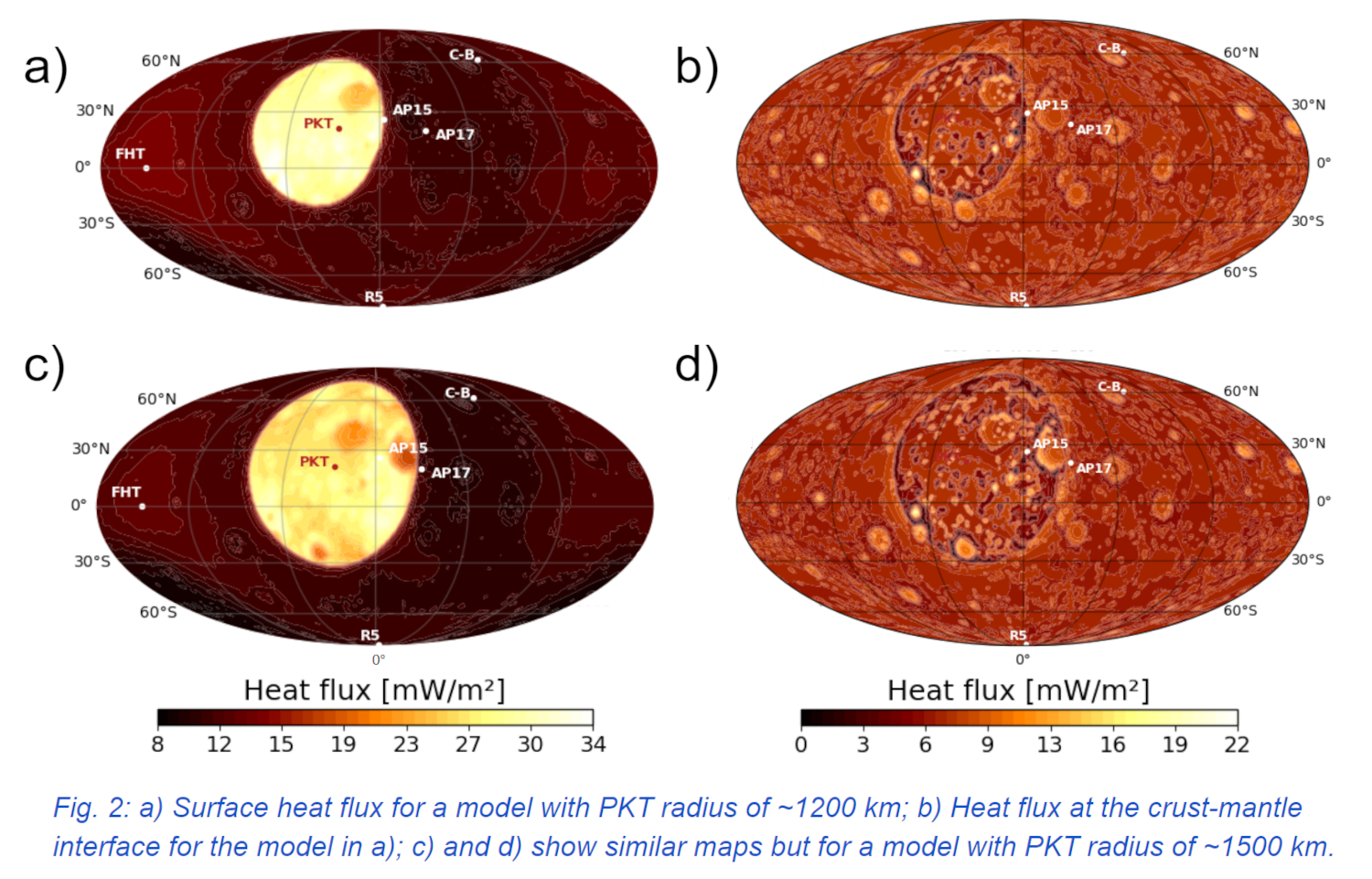The present-day surface heat flux of the Moon from global geodynamic and crustal thickness models.
- 1German Aerospace Centre (DLR), Berlin, Germany
- 2Delft University of Technology, Delft, The Netherlands
The surface heat flux provides important constraints on the present-day thermal state of the lunar interior. In situ surface heat flux measurements, performed during the Apollo program, obtained surface heat flux values of 21±3 and 14±2 mW/m2 at the landing sites of Apollo 15 and 17, respectively [1]. Recently, a peak heat flux of ~180 mW/m2 was inferred by [2] from the Chang’E 1 and 2 data at the Compton-Belkovich location. A lower bound for global lunar heat flux of ~6 mW/m2, based on measurements of the Diviner Lunar Radiometer Experiment onboard LRO, has been suggested for Region 5, a location at the eastern edge of Haworth crater [3]. In addition to heat flux measurements, global thermal expansion/contraction estimates can be used to constrain the thermal state of the interior throughout lunar history [4].
Differences between the surface heat flux measurements, even for geographically close regions, indicate a high heat flux variability on the Moon. Previous work investigated regional combinations of crustal thermophysical properties (thickness, density, thermal conductivity), distribution of heat producing elements (HPEs), and heat flux coming from the mantle to explain the differences between the two Apollo measurements [5,6]. The results of these regional-scale models suggested heat-flux values of 7-13 mW/m2 and 12-14 mW/m2 at the crust-mantle interface and for the global average, respectively. These studies also highlighted the need to include regional-scale scenarios within global thermal evolution models and investigate key aspects (e.g., the geographical extent of a subsurface KREEP layer), in order to relate local heat flux measurements and regional-scale estimates to the global properties of the Moon.
Here, we construct 3D thermal evolution models using the fluid solver GAIA [7]. The interior dynamics of the Moon are simulated over 4.5 billion years, by solving the conservation equations of mass, linear momentum and thermal energy. Similar to [8], we account for spatially variable crustal thickness, derived from gravity and topography data [9] (Fig. 1a). We consider higher HPEs abundances in the PKT and crust compared to the mantle, and compute the interior dynamics (Fig. 1b) using an Arrhenius viscosity for diffusion creep similar to [11]. This setup is designed to allow for an extensive investigation of lunar crustal properties and their spatial variability.

In our models we vary critical parameters such as the location, size, thermal conductivity, and HPE enrichment of the PKT region, but also the location of a putative KREEP layer (i.e., within or below the crust). Finally, we consider various thermal conductivity values and HPE enrichment of the anorthositic crust, and initial temperature profile of the interior. In addition to present-day surface heat flux, we compute the heat flux at the crust-mantle interface and also estimate the time-variable thermal expansion/contraction during lunar evolution. These values are compared to all available constraints [1-6] to select best-fit models.
Our models that are best compatible with the Apollo measurements are in agreement with [5] and [6]. These models have a bulk uranium content of 25 ppb [11], and show average and standard deviation surface and crust-mantle interface heat flux values of ~14±5 and ~8±1 mW/m2, respectively (Fig. 2a and b). For the Compton-Belkovich anomaly, none of our models can reproduce the high heat flux value proposed by [2]. Therefore, we conclude that the inferred heat flux value of ~180 mW/m2 indicates either very specific local processes (e.g., overly high radiogenic enrichment) [2] or large measurement uncertainties.

We find that, without considering 3D lateral variability in thermal conductivity across the lunar surface, measurably lower heat flux values at Region 5 [3] with respect to Apollo 15 & 17 require for KREEP material to extend at least partly beneath mare Serenitatis. In this case, the Apollo 15 measurement would be representative of the PKT average heat flux, while Apollo 17 would lie on its edge (Fig. 2c). On the other hand, a smaller PKT could imply that the low heat flux at Region 5 is caused by different phenomena, for instance a laterally variable thermal conductivity. Heat flux measurements that will be performed by the Farside Seismic Suite [12] at Schrödinger crater, if successful, will provide key information that would help to exclude one of these two scenarios, and thus potentially constrain the extent on the KREEP layer underneath PKT region.
The full spatial variations of the surface heat flux on the Moon obtained by our models are an important step forward towards understanding the thermal history and present-day state of the lunar interior. Such models can help to put current and future heat flux measurements into a global context and to constrain the distribution of the KREEP layer beneath the PKT region. Future work will include a laterally variable thermal conductivity of the crust to test the effects of the spatial distribution of lunar regolith on the surface heat flow and subsurface temperature variations.
References:
[1] Langseth et al., 1976; [2] Siegler et al., 2023; [3] Paige & Siegler, 2016; [4] Andrews-Hanna et al. 2013; [5] Siegler and Smrekar, 2013; [6] Warren and Rasmussen, 1987; [7] Hüttig et al., 2013; [8] Plesa et al., 2016; [9] Broquet & Andrews-Hanna, 2023; [11] Laneuville et al., 2013 [12] Panning et al., LPSC 2024.
How to cite: Santangelo, S., Plesa, A.-C., Broquet, A., Breuer, D., and Root, B. C.: The present-day surface heat flux of the Moon from global geodynamic and crustal thickness models., Europlanet Science Congress 2024, Berlin, Germany, 8–13 Sep 2024, EPSC2024-959, https://doi.org/10.5194/epsc2024-959, 2024.